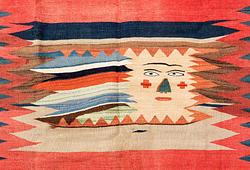Piet Mondrian
Barn doors of a Brabant farm building
Signed P. Mondriaan. Executed 1904. Water colour, gouache, crayon and possible charcoal on paper, 47 x 62 cm. The RKD will add Barn doors of a Brabant farm building to Mondrian’s digital oeuvre catalogue, which was published online at catalogue.pietmondrian.nl in 2017, in anticipation of the Mondrian Edition project.
Provenance
Director Marius Johannes Heybroek (brother to Greta Heybroek, previous fiancée to Piet Mondrian) some time between 1905-1911.
Mary von Limburg-Stirum, née Heybroek.
As a gift to Bessy Peterson, Västervik, in the 1970s.
Thence by descent within the family to the present owner.
More information
The watercolour with barn doors was painted by Mondrian in 1904, during a retreat in Brabant.
It was Albert Pieter van den Briel who, in 1904, invited his friend Mondrian to come to Brabant, where van den Briel worked as an agricultural engineer for the KNHM Foundation. Mondrian stayed the entire year in the village of Uden and painted in various places in the area, including Veghel and Nistelrode. The recently discovered Barn doors of a Brabant farm building may have originated in Nistelrode. The work is a modern composition of part of a barn with two wooden doors that fills the entire sheet. At the top the image is cut off by a thatched roof, at the bottom by a yard with some scratching chickens and on the right by another barn. Thanks to correspondence from van den Briel, we know that Mondrian added contrasting white and blue accents to the dominant reddish-brown tones of the composition. This observation is consistent with the newly discovered watercolour, in which blue and white accents are visible in the roof tiles, bricks and barn doors. Mondrian’s virtuoso use of black and red chalk, watercolour and gouache resulted in a clear composition made up of large areas. According to Wietse Coppes, Mondrian expert at the RKD, this watercolour can be considered one of the highlights of the thirty or so paintings, drawings and watercolours that Mondrian produced in Brabant.
Van den Briel wrote that Mondrian ‘made numerous studies of barns with square door areas, in ever-changing and varying colours in Brabant. […] It would be [...] of great importance, also in connection with later, non-figurative, work, which forms a final phase of this, if some of these studies could be found again’. Two other works featuring the same barn doors – a pencil drawing and an oil sketch – are part of the Kunstmuseum Den Haag collection. It was the similarities with the oil sketch, in particular, that were of great importance in determining the authenticity of the new discovery. Mondrian often made several studies of the same subject on location, often in different media. He then worked his sketches up into fully fledged paintings in his studio. It remains unclear whether this watercolour was made outdoors or in the studio. It is the most detailed of the three known renderings of the barn. The roof tiles, bricks and scratching chickens are clearly recognisable in the watercolour.
Provenance
The work was probably bought by Marius Johannes Heijbroek, brother of Gretha Heijbroek, between 1905 and the end of 1911. Mondrian’s brief engagement to Gretha, a merchant’s daughter from Amsterdam, began in the autumn of 1911. The Heijbroek family acquired several works by the artist, including the monumental Sun, Church in Zeeland from 1909-1910, which is now part of the collection of Tate Modern in London. In 1933, Marius Johannes Heijbroek emigrated to Sweden, his wife’s homeland, taking the watercolour with him. It remained in the family until 1970, when it was donated to a Swedish family who were friends of the Heijbroek family. Through inheritance, it has remained in that family until today.
















































































